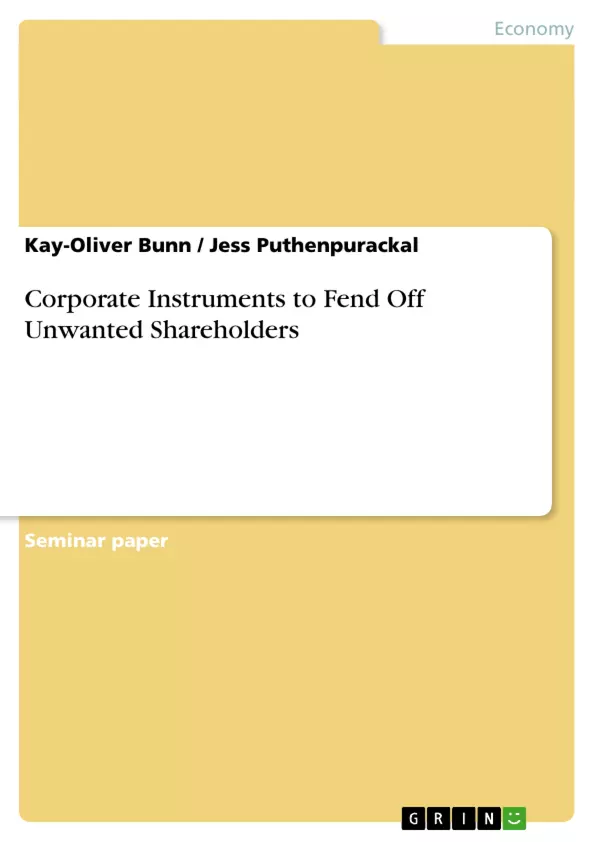As markets today mostly develop and change faster than companies can grow, the option of taking over other companies has become core to strategic management seeking to expand the company’s business and to create value for both customers and stakeholders. Hence M & A activities have significantly increased in today’s business world of fast changing global economies and emerging competition. This development forces prospective target companies to take action to protect themselves against hostile takeovers.
In order to determine effective defence strategies and to apply appropriate anti-takeover instruments, many aspects such as motives and practical approach of the attacking company as well as a variety of legal frameworks and shareholder interests have to be reviewed diligently.
This paper delivers a concentrated overview of the topic’s most important aspects and delineates some of the most common instruments to fend off unwanted shareholders. Particular attention is thereby payed to these instruments’ impact on stock prices of both the attacking and the target company.
The authors hereunto present and interpret a significant amount of empirical evidence taken from real business cases where the previously discussed defence instruments were actually applied.
Inhaltsverzeichnis (Table of Contents)
- 1. Introduction
- 1.1. Problem definition
- 1.2. Procedure
- 2. Takeover motives
- 2.1. Strategic Motives
- 2.1.1. Market Motives
- 2.1.2. Capacity Motives
- 2.1.3. Risk Motives
- 2.2. Financial Motives
- 2.2.1. Capital market related motives
- 2.2.1.1. Access to capital markets
- 2.2.1.2. Undervaluation and restructuring
- 2.2.2. Motives of balance and tax policy
- 2.2.2.1. Balance sheet policy
- 2.2.2.2. Tax policy
- 2.3. Personal Motives
- 3. Techniques of a hostile takeover
- 3.1. Tender offer
- 3.2. Dawn Raid
- 4. Takeover defence instruments
- 4.1. Important legal restrictions and frameworks
- 4.2. Preventive measures
- 4.2.1. Poison Pill
- 4.2.2. Golden Parachutes
- 4.2.3. Golden Shares
- 4.2.4. Share Buyback
- 4.2.5. White Squires
- 4.3. Reactive Measures (ad-hoc measures)
- 4.3.1. White Knight
- 4.3.2. Crown Jewels
- 4.3.3. Investor Relations
- 5. Cases
- 5.1. ABN Amro
- 5.2. Endesa
- 5.3. Bayerische HypoVereinsbank
- 5.4. Mannesmann
Zielsetzung und Themenschwerpunkte (Objectives and Key Themes)
This case study analyzes corporate instruments used to defend against unwanted shareholders. The study aims to examine the various motives behind hostile takeovers and to evaluate the effectiveness of different defensive strategies. It does this through detailed case studies of several prominent takeover battles.
- Motives for hostile takeovers (strategic, financial, and personal)
- Techniques employed in hostile takeovers
- Defensive instruments used by target companies (preventive and reactive)
- Effectiveness of different defensive strategies
- Empirical analysis of stock price performance in the context of takeover battles
Zusammenfassung der Kapitel (Chapter Summaries)
Chapter 1 introduces the problem of unwanted shareholders and outlines the study's methodology. Chapter 2 explores various motives behind takeovers, categorizing them into strategic, financial, and personal reasons. Chapter 3 details common techniques used in hostile takeover attempts, including tender offers and dawn raids. Chapter 4 delves into the spectrum of defensive instruments available to target companies, differentiating between preventive measures such as poison pills and golden parachutes, and reactive measures such as employing white knights or utilizing crown jewels strategies. Chapter 5 presents case studies of several notable takeover attempts, examining the specific circumstances, employed strategies and their respective outcomes.
Schlüsselwörter (Keywords)
Hostile takeovers, corporate defense mechanisms, takeover motives, mergers and acquisitions (M&A), poison pill, golden parachute, golden shares, white knight, white squire, crown jewels, investor relations, share buyback, tender offer, dawn raid, ABN Amro, Endesa, Bayerische HypoVereinsbank, Mannesmann.
- Quote paper
- Dipl.-Kfm. (FH), BBA Kay-Oliver Bunn (Author), Dipl.-Kfm. (FH), BBA Jess Puthenpurackal (Author), 2008, Corporate Instruments to Fend Off Unwanted Shareholders, Munich, GRIN Verlag, https://www.grin.com/document/125489



